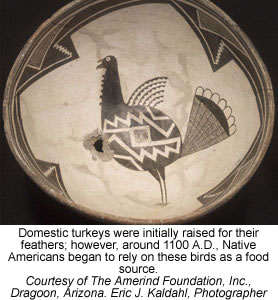 |
Canku Ota
|
 |
|
(Many Paths)
|
||
|
An Online Newsletter
Celebrating Native America
|
||
|
March 1, 2010 - Volume
8 Number 3
|
||
|
|
||
|
Native Americans
First Tamed Turkeys 2,000 Years Ago
|
||
|
by Jennifer Viegas -
Discovery News
|
||
|
The turkeys we eat today ultimately descended from breeds raised by the Aztecs.
The two instances of domestication appear to have been separate, based on DNA analysis of ancient turkey remains. However, the different Native American groups could have been in contact with each other, sharing turkey-raising tips. While turkeys today conjure up thoughts of bountiful roast meat meals and deli sandwiches, Native Americans were not driven by their dinner needs, according to the study, published in the latest Proceedings of the National Academy of Sciences. "Interestingly, the domestic turkeys were initially raised for their feathers, which were used in rituals and ceremonies, as well as to make feather robes or blankets," lead author Camilla Speller told Discovery News. "Only later, around 1100 A.D., did the domestic turkeys become an important food source for the Ancestral Puebloans." Speller's colleague, Dongya Yang, said the new study came together when two groups joined forces. Their group was busy studying ancient turkey bones, while another research team from Washington State University was analyzing early turkey coprolites, i.e. fossilized dung from the birds. The scientists combined their efforts for the study, which involved DNA analysis of 149 turkey bones and 29 coprolites from 38 different archaeological sites. Speller said their investigations revealed that pre-Aztec people around south-central Mexico first domesticated turkeys. The birds appear to either have either been penned or "allowed to roam around the village," according to Speller. The southwestern turkeys, on the other hand, "were raised by the Ancestral Puebloans who lived on the Colorado Plateau, around the Four Corners region of the southwest United States," Speller said. These Puebloans, also known as the Anasazi, appear to have not only raised domestic turkeys, but also incorporated local wild turkeys into their domestic stocks, according to Yang. DNA tests determined that the southwestern domestic turkey breed probably is most closely related to the eastern and Rio Grande wild turkeys that are still found in the U.S. today. It is possible, however, that the original southwestern domestic breed has since become extinct. "It seems that only the Aztec turkey breed survived into the present day," Speller said. "It's fascinating to think that the turkeys that we eat today were ultimately descended form the turkey breeds raised by the Aztecs." The researchers weren't able to precisely identify these Aztec turkey breeds, but they ruled out at least one early progenitor: the South Mexican domestic turkey, which previously was thought to be a mother of all modern domestic turkeys. The connection to today's domestic turkeys is a complicated one, because when the Spanish arrived in the New World, they transported the Aztec turkey breeds from Mexico to Europe, where they were a huge hit. "Over the following two centuries, several varieties of turkey were developed in Europe. And then in the 18th century, these European turkey breeds were imported back to the United States, where they eventually became the forerunners to the turkeys we eat today," Speller explained. Anthropologist R.G. Matson of the University of British Columbia is an expert in the archaeology of the southwestern United States. He told Discovery News that Speller and her team "have provided convincing evidence that two turkey domestication events took place." Matson, however, indicated that questions remain. "Clearly more wild, museum and archaeological samples need to be analyzed to fill out the history of turkey domestication in the Southwest and elsewhere," he said. |
|
|
||
|
|
||
| Canku Ota is a free Newsletter celebrating Native America, its traditions and accomplishments . We do not provide subscriber or visitor names to anyone. Some articles presented in Canku Ota may contain copyright material. We have received appropriate permissions for republishing any articles. Material appearing here is distributed without profit or monetary gain to those who have expressed an interest. This is in accordance with Title 17 U.S.C. Section 107. | ||
|
Canku Ota is a copyright ©
2000, 2001, 2002, 2003, 2004, 2005, 2006, 2007, 2008, 2009, 2010
of Vicki Barry and Paul Barry.
|
||
 |
 |
|
|
The "Canku
Ota - A Newsletter Celebrating Native America" web site and
its design is the
|
||
|
Copyright ©
1999, 2000, 2001, 2002, 2003, 2004, 2005,
2006, 2007, 2008, 2009, 2010
of Paul C. Barry.
|
||
|
All Rights Reserved.
|
||
 More
than 1,500 years before Christopher Columbus and his crew sailed
to the New World, Native Americans had already domesticated turkeys
twice: first in south-central Mexico at around 800 B.C. and again
in what is now the southwestern U.S. at about 200 B.C., according
to a new study.
More
than 1,500 years before Christopher Columbus and his crew sailed
to the New World, Native Americans had already domesticated turkeys
twice: first in south-central Mexico at around 800 B.C. and again
in what is now the southwestern U.S. at about 200 B.C., according
to a new study.